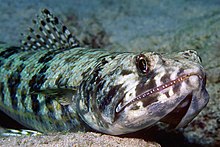Synodontidae
| Lizardfishes Temporal range:[1]
| |
|---|---|

| |
| Synodus intermedius | |
| Scientific classification | |
| Domain: | Eukaryota |
| Kingdom: | Animalia |
| Phylum: | Chordata |
| Class: | Actinopterygii |
| Order: | Aulopiformes |
| Suborder: | Synodontoidei |
| Family: | Synodontidae T. N. Gill,1862 |
| Genera | |
| Synonyms | |
|
Harpadontidae | |
TheSynodontidaeorlizardfishes[note 1]arebenthic(bottom-dwelling) marine and estuarine bony fishes that belong to theaulopiformfish order,a diverse group of marine ray-finned fish consisting of some 15 extant and several prehistoric families. They are found in tropical and subtropical marine waters throughout the world.
Lizardfishes are generally small, although the largest species measures about 60 cm (24 in) in length. They have slender, somewhat cylindrical bodies, and heads that superficially resemble those oflizards.Thedorsal finis located in the middle of the back, and accompanied by a smalladipose finplaced closer to the tail.[2]They have mouths full of sharp teeth, even on the tongue.[1]
Lizardfishes are benthic animals that live in shallow coastal waters; even the deepest-dwelling species of lizardfish live in waters no more than 400 m (1,300 ft) deep. Some species in the subfamilyHarpadontinaelive inbrackishestuaries.They prefer sandy environments, and typically have body colours that help to camouflage them in such environments.[2]
Thelarvaeof lizardfishes are free-swimming. They are distinguished by the presence of black blotches in their guts, clearly visible through their transparent, scaleless skin.
While it may not be as well known as some other types of fish, it is still consumed in many cultures and can be used in a variety of culinary preparations.
Taxonomy
[edit]Three genera of the Synodontidae are known to inhabit the western Atlantic, includingSynodus,represented by six species,Saurida,represented by four species, andTrachinocephalus,represented by a single species.[3]The six species comprising the genusSynodusareS. intermedius,S. saurus,S. synodus,S. foetens,S. bondi,andS. macrostigmus.[3]The four species comprising the genusSauridaareS. umeyoshii,S. pseudotumbil,S. undosquamis,andS. tumbil.The single species ofTrachinocephalusisT. myops.The extinctArgillichthysis represented only by a single species,A. toombsi,from theEocene-agedLondon Clayformation.[2]
See also
[edit]- Bombay duck
- Deepsea lizardfish
- USSLizardfish(a US submarine)
Notes
[edit]- ^(ortypical lizardfishto distinguish them from theBathysauridaeandPseudotrichonotidae)
References
[edit]- ^abFroese, Rainer, and Daniel Pauly, eds. (2008)."Synodontidae"inFishBase.December 2008 version.
- ^abcJohnson, R.K. & Eschmeyer, W.N. (1998). Paxton, J.R. & Eschmeyer, W.N. (eds.).Encyclopedia of Fishes.San Diego: Academic Press. pp. 123–124.ISBN0-12-547665-5.
- ^abBenjamin W. Frable; Carole C. Baldwin; Brendan M. Luther & Lee A. Weigt (March 2013)."A New Species of Western Atlantic Lizardfish (Teleostei: Synodontidae:Synodus) and Resurrection ofSynodus bondiFowler, 1939, as a Valid Species from the Caribbean with Redescriptions ofS. bondi,S. foetens(Linnaeus, 1766), andS. intermedius(Agassiz, 1829) "(PDF).Fish. Bull.111(NMFS Fishery Bulletin): 122–146.doi:10.7755/FB.111.2.2.
